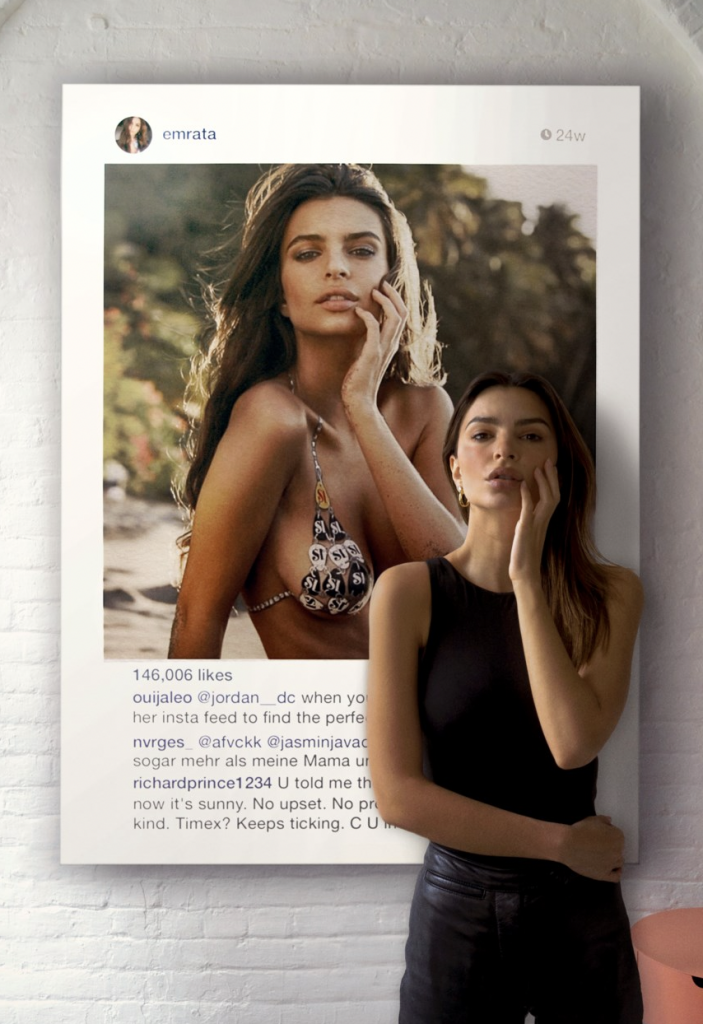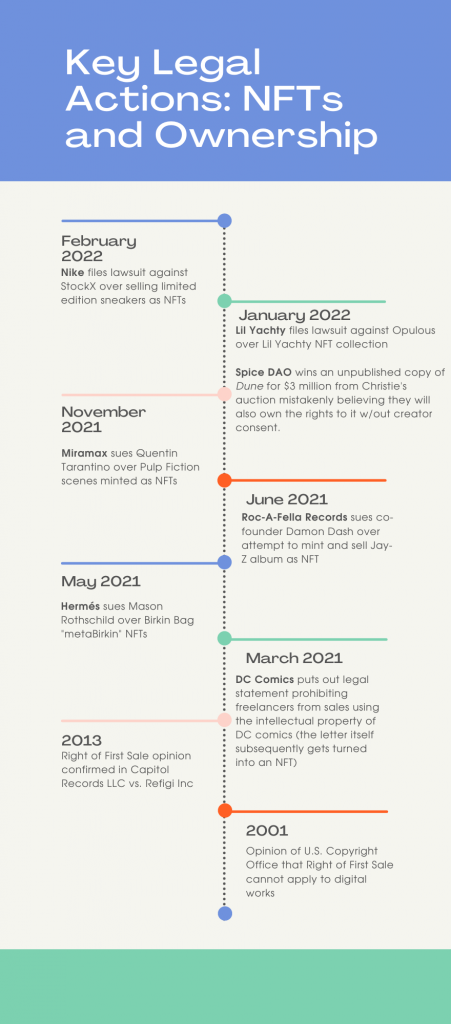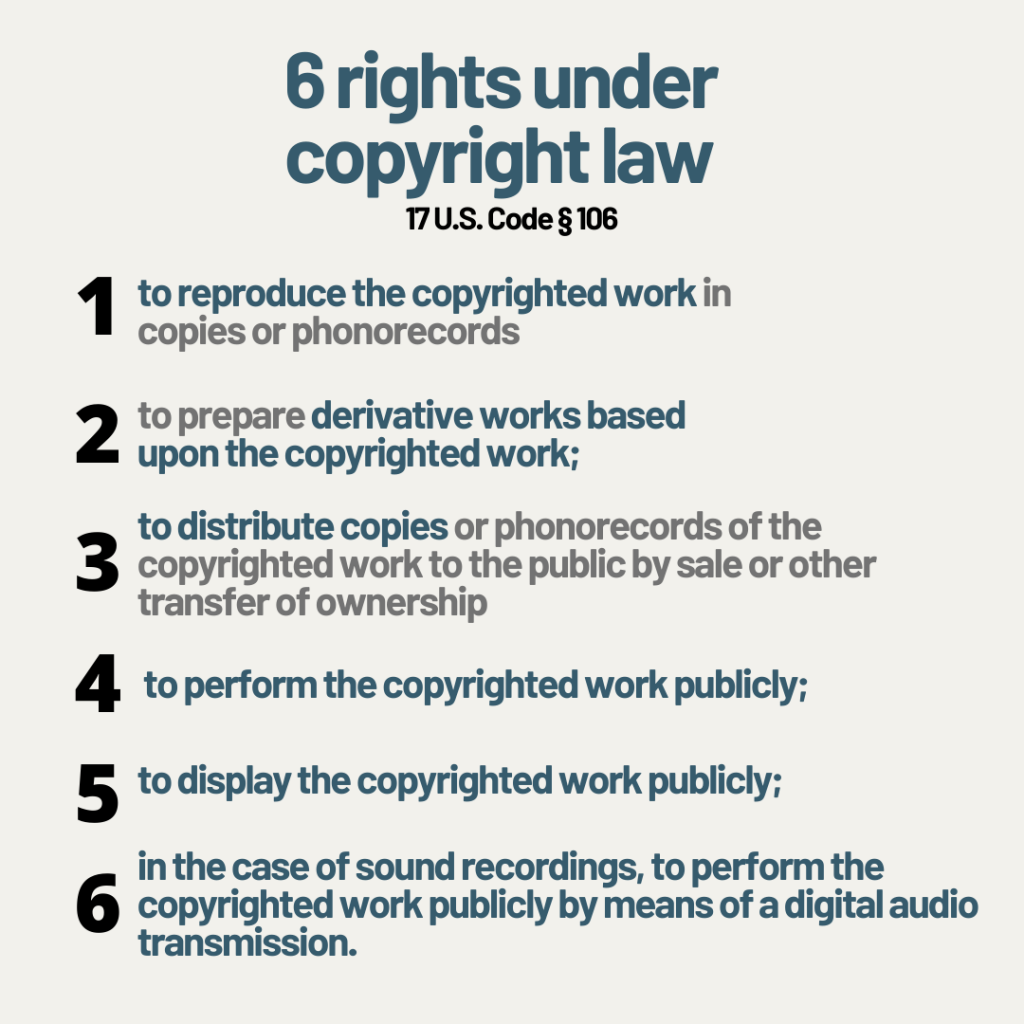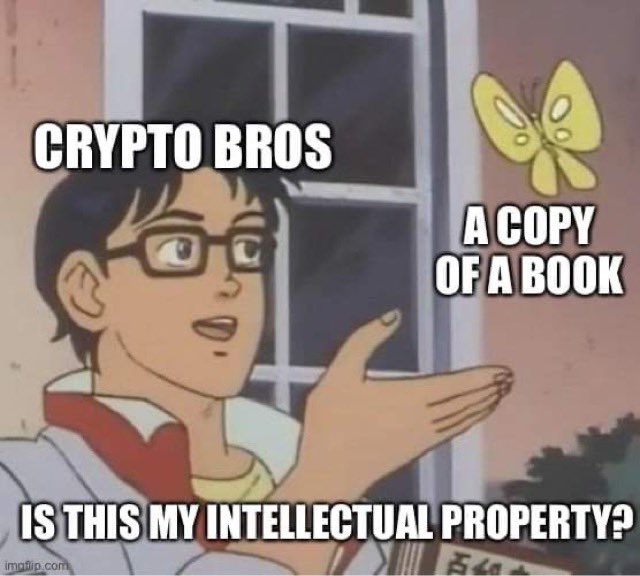
Emily Ratajkowski minted an NFT called “Buying Myself Back.” The NFT was sold by Christie’s Auction House for $175,000.
The swimsuit image of Ratajkowski is from Sports Illustrated, which owns the image. The Instagram post wall hanging is actually a piece by artist Richard Prince, who Ratajkowski criticized for stealing her image without permission. The overall image of her standing in front of the piece is the NFT itself. The NFT is Ratajkowski’s statement of ownership involving two pieces that she legally does not own the copyright to.
“Buying Myself Back” is both a statement on the lack of autonomy models have over their own image and a perfect metaphor for the layers of ownership and copyright issues involved in the sphere of NFTs. The question is: Could Sports Illustrated take legal action for Ratajkowski’s resale of the image? Could Richard Prince? What would it look like if they did? And would Christie’s hold any liability?
Digital Ownership
Non-fungible Tokens or NFTs have taken the world by storm over the past few years. As NFTs skyrocket into a common commodity, legal issues are already rearing their heads. The selling promise of NFTs providing enhanced digital ownership brings with it both exciting opportunities and legal confusion. NFTs provide a framework to understand how our current Intellectual Property and Copyright laws might not be suitable for the new web 3.0. How arts organizations navigate these dilemmas may be crucial as the first wave of NFT litigations make their way through court.
The culture of the NFT landscape is imbued with an air of invincibility, especially around ownership. While many may consider NFTs a wild west, free of penalty, it may just be because we haven’t established the laws that will restrict and hold accountable those dealing in NFTS. As we see these issues making their way into both the public and legal spheres, it’s time to rethink key stakeholders’ roles in the process and how they might be implicated in legal spheres. Some of the most highlighted issues we are seeing are Intellectual Property ownership and blatant art theft with NFTs.
Timeline of some key NFT ownership lawsuits:

These cases are still working their way through the legal system, and their outcomes will be telling about how we will manage ownership issues and NFTs in the future.
U.S. Copyright Code: Does it fit on the blockchain?
To give some insight into the current legal infrastructure these cases are built around, I will outline some of the key sections of United States copyright law that come into play here.
The key laws surrounding the issue of ownership and NFTS fall under Title 17 of the U.S. Code, which enforces copyright. Specifically sections 109, 106, and 504 are relevant to this discussion.
U.S. Title 17, Section 109 is also known as The Right of First Sale doctrine. It established that, should someone purchase a physical object, let’s say a painting, from the creator, they legally do not have to obtain permission from the creator in order to resell or do what they wish with the object. Digital objects are a different story. In 2001, the United States Copyright office offered the opinion that the Right of First Sale could not apply to digital objects (as they are inherently copies of an original), and this opinion was confirmed in Capitol Records LLC vs. ReDigi Inc in 2013. An individual who purchases a digital object is not, by law, entitled to its ownership inherently. So what does this mean in the context of NFTs, whose existence on the blockchain is supposed to represent unique and exclusive ownership? This is where things get muddy.
Section 106 outlines the exclusive rights of the copyright holder. These are:

An individual who creates a piece of digital art is entitled to these rights surrounding their art. When it is minted as an NFT and sold, these rights are not automatically transferred to the buyer. Much of the confusion surrounding NFT ownership comes in here: many buyers believe that purchasing the work also entitles them to these 6 rights of ownership.
One example of such confusion is Spice DAO’s purchase of an NFT unpublished manuscript of Dune. Shortly after the 3 million dollar sale, Spice DAO tweeted what they would be doing with the copy, including making it public and using it for other projects. However, as the original creators later made clear, they were not entitled to publicizing or recreating it just for buying it. The only thing they got from the sale was personal access to the manuscript. Because the original creators remained the copyright holders through the transaction, they are still the only ones entitled to the rights. Despite the mockery Spice DAO faced on Twitter for this misinterpretation, it does reveal how people think about what they are entitled to when they purchase an NFT.

Some lawyers in the blockchain sphere believe our copyright laws should evolve to recognize the buyer of an NFT as the legal copyright owner. But what might that mean for artists whose work is stolen and resold as NFTs? Could this be a viable change before we have established more protection for artists?
Art Theft, Opensea, and DeviantArt
One of the major issues in the scope of NFTs right now is art theft. Despite the fact that the NFT marketplace creates contract systems under which artists can collect royalties on resales of their work (a huge milestone for visual artists) when it comes to art theft, this system can become much more dangerous. In order to mint an NFT on platforms like Opensea, a user does not have to prove identity, just has to have a crypto wallet. The person creating the NFT simply uploads a JPEG and then mints it at their own set price, with their own stipulations on its resale and the rights that come with the NFT. It gets sold, and then resold.
Many cases have been surfacing of artists finding their original artwork being sold for thousands of dollars on the NFT marketplace without their permission. A Banksy copycat made out with $900,000 in lookalike NFTS. Deceased artist Qinni’s work was reproduced and sold shortly after her death as NFTs. With little legal and financial recourse, artists have started to depend on one another to monitor the marketplace for stolen art. A Twitter account, @NFTtheft, exposes and reshares stolen art NFTs and asks followers to mass report the fraudsters.
Part of this issue, as I mentioned, is the lack of verification needed to actually mint an NFT. The other part is that platforms like Opensea and Rarible do little to prevent it from happening again. Let’s say you are a digital artist and you see your art on Opensea being sold for thousands of dollars. You can report the user, verify your identity and proof of ownership, and Opensea might take the fraudulent account down. Little ensures the fraudulent account owner won’t just create another account and do the same thing again. On top of that, the original artists cannot claim any of the profit made by the scammer, and Opensea doesn’t retrieve any of that profit.
This system also poses threats to NFT buyers. If someone, even unknowingly, resold a stolen image, they would be held liable should this issue go to court. Violating someone else’s copyright, whether intentional or not, could result in damages of $750-30,000 per infringement should the issue ever be seen in court. The risk this poses to NFT collectors shouldn’t be overlooked, and it is something anyone purchasing an NFT should consider before buying.
One platform is trying to change this. DeviantArt, the world’s largest digital art platform, has developed an AI system that scans both its website and NFT marketplaces to find matches. When a match between the DeviantArt site and NFT marketplace is found, it alerts the original artist on DeviantArt that their work is being sold as an NFT. According to DeviantArt, “infringement related to art theft bot attacks dropped over 600%” since their initial launch of the program.
Implications for Arts Organizations
Art museums, galleries, and auction houses have been getting in on the NFT game. Most notably, Christie’s NFT auction in 2021 ended in over 3 million in sales. The Dune NFT was purchased through Christie’s auction. So, assuming that it is possible for stolen art to be sold as NFTs through the platform of a Christie’s auction, could Christie’s be held liable? And what responsibility does the art organization have to protect both artists and buyers?
Legal responsibility in situations like this is quite layered. If you were to buy an NFT from a Christie’s auction, you would directly or indirectly be dealing with: (1) the original NFT creator, (2) Christie’s, (3) the NFT marketplace such as Opensea, and (4) a cryptocurrency wallet application. Christie’s Auction House has a Terms of Sale document, Opensea has a Terms of Service agreement, and the Crypto Wallet where the exchange takes place has a Terms of Use policy. Also, the NFT itself may be coded with both a Smart Contract and a License Agreement. Which links of this chain should be held responsible for art theft?
Take Christie’s Conditions of Sale, for example. The document is 31 pages long and contains one small paragraph on the sale of NFTs, which states “we expressly disclaim all implied warranties as to the NFTs, including, without limitation, implied warranties of merchantability, fitness for a particular purpose, title and non-infringement. We cannot and do not represent or warrant that an NFT is reliable, current, or error-free…”
It begs the question of whether we should be asking for more accountability on the part of the art organization, the NFT marketplace, or both. What we might be seeing in the future is more vast applications of AI such as DeviantArt Protect in order to protect actual arts organizations from liability, and for them to protect the artists they represent. In many ways, as legal precedent is awaited, it is up to the arts organizations to decide what role of responsibility they play when it comes to intellectual property and copyright threats with NFTs. If the medium of sale is found to be liable in some of these cases, it poses a huge challenge for arts organizations eager to jump in to the NFT scene. For now, we wait to see who the courts hold accountable.
Sources:
LII / Legal Information Institute. “17 U.S. Code § 117 – Limitations on Exclusive Rights: Computer Programs.” Accessed May 1, 2022. https://www.law.cornell.edu/uscode/text/17/117.
Christie’s. “Appendix A: New York Conditions of Sale.” Christie’s. Accessed April 13, 2022. https://www.christies.com/media-library/pdf/conditions-of-sale/new-york-conditions-of-sale.pdf.
Crow, Kelly. “NFT Art the Latest Target for Online Fraudsters.” Financial News London, August 26, 2021. https://www.fnlondon.com/articles/nft-art-the-latest-target-for-fraudsters-20210826.
Cointelegraph. “Crypto DAO Spends €2.66M on Jodorowsky’s Dune Thinking They Would Own Its Copyright, Receives Mass Ridicule on Twitter.” Accessed April 19, 2022. https://cointelegraph.com/news/crypto-dao-spends-2-66m-on-jodorowsky-s-dune-thinking-they-would-own-its-copyright-receives-mass-ridicule-on-twitter.
“DeviantArt Protect: 80,000 NFT Alerts Sent by Team on DeviantArt.” Accessed April 20, 2022. https://www.deviantart.com/team/journal/DeviantArt-Protect-80-000-NFT-Alerts-Sent-902819882.
Fisher, Katya. “Once Upon a Time in NFT: Blockchain, Copyright, and the Right of First Sale Doctrine.” Cardozo Arts & Entertainment Law Journal 37, no. 3 (2019): 629-.
Goldstein, Caroline. “Model Emily Ratajkowski Blasted Richard Prince for Stealing Her Image. Now, She’s Taking It Back—and Selling It as an NFT.” Artnet News, April 23, 2021. https://news.artnet.com/market/emily-ratajkowski-nft-christies-1961581.
Graves, Franklin. “Sorry, Your NFT Is Worthless: The Copyright and Generative Art Problem for NFT Collections.” IPWatchdog.com | Patents & Patent Law, February 20, 2022. https://www.ipwatchdog.com/2022/02/20/sorry-nft-worthless-copyright-generative-art-problem-nft-collections/id=146163/.
Hale, Christine E, and Courtney Rogers Perrin. “NFT Lawsuits 2022 Roundup.” Lexology (blog). Mondaq Ltd, 2022. https://www.lexology.com/library/detail.aspx?g=1ce96c95-b567-4230-bbd5c71f0ac3c0d3#:~:text=In%20November%202021%2C%20production%20company,his%20handwritten%20Pulp%20Fiction%20script.
Kastrenakes, Jacob. “How Many Layers of Copyright Infringement Are in Emily Ratajkowski’s New NFT?” The Verge, April 24, 2021. https://www.theverge.com/2021/4/24/22399790/emily-ratajkowski-nft-christies-copyright-nightmare-richard-prince.
Kwan, Jacklin. “An Artist Died. Then Thieves Made NFTs of Her Work.” WIRED UK, July 28, 2021. https://www.wired.co.uk/article/nft-fraud-qinni-art.
Mackenzie, Simon, and Diana Berzina. “NFTs: Digital Things and Their Criminal Lives.” Crime, Media, Culture, August 19, 2021. https://journals.sagepub.com/doi/full/10.1177/17416590211039797.
Mattei, Shanti Escalante-De. “Christie’s NFT Auction with OpenSea Concludes with Middling $3.6 M. Result.” ARTnews.Com (blog), December 8, 2021. https://www.artnews.com/art-news/market/christies-opensea-nft-sale-1234612759/.
The NFTtorney. “New Digital World, Old Legal Rules,” January 31, 2022. https://nfttorney.com/2022/01/31/new-digital-world-old-legal-rules/.
The NFTtorney. “OpenSea Just Saved Their Users Millions in Potential Copyright Damages,” July 15, 2021. https://nfttorney.com/2021/07/15/opensea-just-saved-their-users-millions-in-potential-copyright-damages/.
“Richard Prince.” Accessed May 1, 2022. http://www.richardprince.com/.
Rizzo, Jessica. “The ‘Dune’ NFT Copyright Fiasco Is the Least of Crypto’s Legal Worries.” Wired. Accessed April 22, 2022. https://www.wired.com/story/nft-cryptocurrency-art-regulation-law/.
Schmalfeld, Jonathan. “Copyright Violations Could Crash the NFT Party.” Fortune, August 4, 2021. https://fortune.com/2021/08/04/nfts-copyright-violations-penalties-non-fungible-tokens-collectibles-nfttorney-jonathan-schmalfeld/.
Tiwari, Anirudh. “‘Wave of Litigation’ to Hit NFT Space as Copyright Issues Abound.” Cointelegraph, February 7, 2022. https://cointelegraph.com/news/wave-of-litigation-to-hit-nft-space-as-copyright-issues-abound.
Los Angeles Times. “This Picture of Emily Ratajkowski Is Free to Look at. But Its NFT Sold for $140,000.” May 17, 2021. https://www.latimes.com/entertainment-arts/story/2021-05-17/emily-ratajkowski-nft-sells-for-140000.